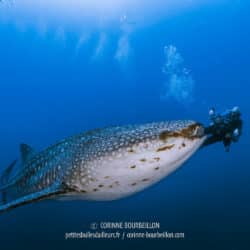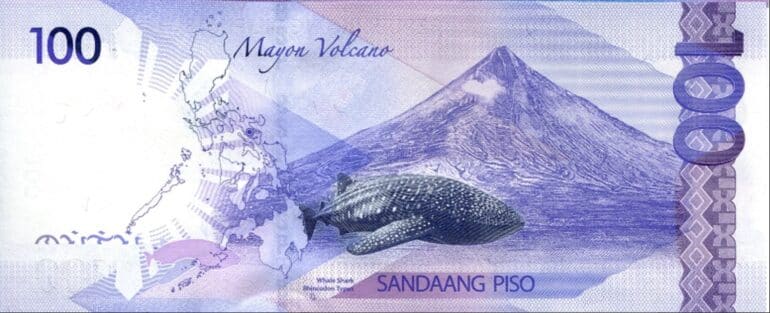Philippines: Sogod Bay [Leyte] + Moalboal [Cebu] + Pangatalan [Palawan] - March 2020
Dear English-speaking readers, this page is an automatic translation of an article originally written in French. I apologise for any strange sentences and funny mistakes that may have resulted. If you read French, click on the French flag below to access the original, correct text:
I'll take you back to Sogod Bay, "the bay of the whale sharks", in the south of the island of Leyte, in the Philippines... On my first trip there in 2008, I missed them. Twelve years later, I was luckier!
The biggest fish in the world
Say the word "whale shark" (or requin-baleine in French) in the middle of an assembly of divers and you will immediately see their eyes shine. Of course, it is the biggest fish in the world. And the most harmless of the great sharks. Enough to make the human beings wearing fins stir...
Moreover, the animal is stylish, with its white geometrical tattoos on its huge tapered body. Really, in my eyes, it is the most beautiful and coolest of all sharks!
😍
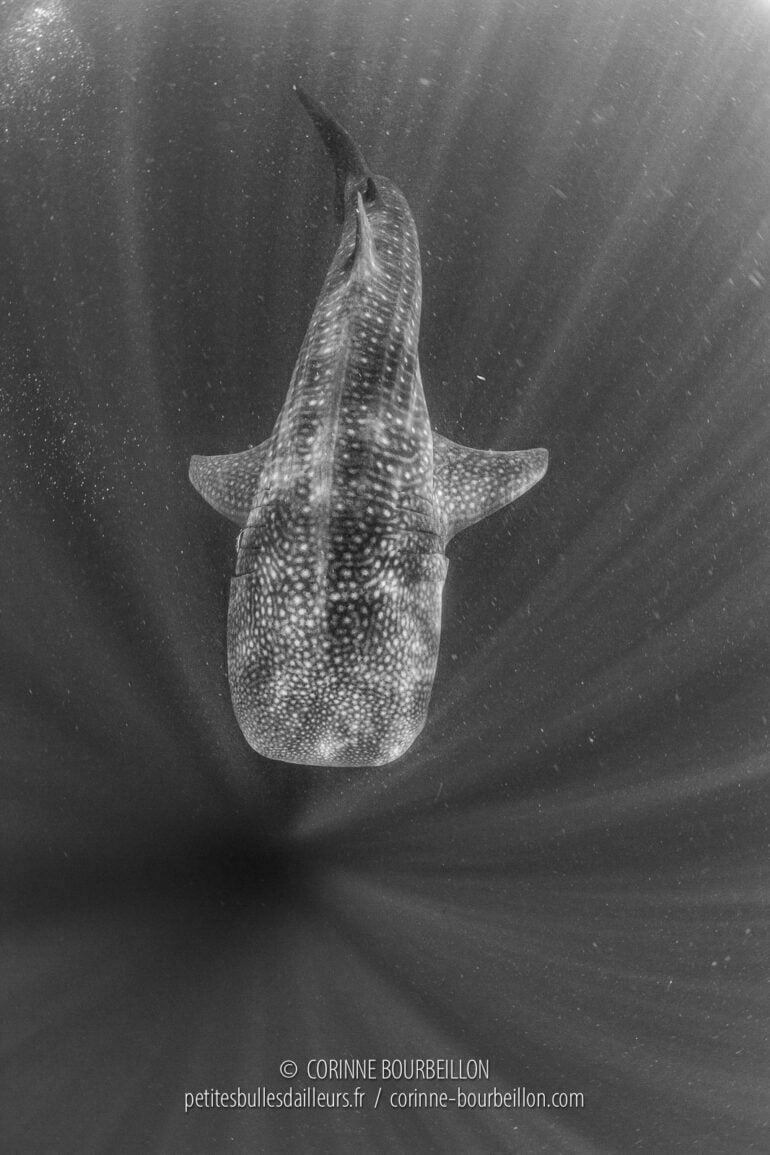
As an adult, the whale shark can exceed 10-12 meters. And even reach 18-20 meters for the biggest! Another similarity with the whale is that this shark has a huge mouth without teeth - well, it's just like that, its teeth are only a few millimeters long. It is not equipped to bite, it is really a gentle monster.
To feed itself, it filters the sea water by opening its mouth wide, gobbling up plankton, small fish and tiny crustaceans. I let you imagine the quantity of proteins needed by such a big animal...
I had already talked a lot about this topic, during two previous diving trips marked by encounters with this big giant of the sea: in the Philippines in 2018, and in Mexico in 2014.
When you like it, you don't count. Impossible to become blasé about the whale shark... So I'm really glad I could add a new episode to the series. It was early 2020, in the Philippines, just before the health crisis...
😉
Back to Sogod Bay, Whale Shark Bay
Whale shark, Rhincodon typus of its scientific name, is protected since 1998 in the Philippines. It is important to keep in mind that it is a rare and threatened species. In 2016, it went from "vulnerable" to "endangered" status on the IUCN red list (International Union for Conservation of Nature).
In the Philippines, it is called butanding, tiki-tiki, tuki or tawiki according to the regions. The waters of the archipelago are frequented by more than 1,950 specimens, according to the Philippine research institute LaMaVe (Large Marine Vertebrates), which makes it one of the largest known whale shark populations in the world.
To hope to see a whale shark, you can force fate a little by going at the right time of the year in areas that it is used to frequent.
Sogod Bay, in the south of the island of Leyte is one of these places. Humans with fins have a good chance to observe these big sharks swimming and feeding along the coast, not far from the small village of Pintuyan.
When? Between February and April. Sometimes a little earlier or later. Scientists at the LaMaVe Institute say they can be seen as early as November and as late as June.

Whale sharks return to Sogod Bay almost every year. Their migrations seem to be closely linked to the southwest monsoon. With a bit of luck, we can meet them by chance underwater, while scuba diving, along the drop offs and coral reefs of the bay.
But the excursions organized specifically to observe them are done on the surface by snorkeling (fins-mask-snorkel). These "whale shark watching tours" are usually organized near the southwest coast of Panaon, this long island of about 30 kilometers, which forms the eastern limit of the bay in the south of Leyte.
I put below a Google Map and the map of the Peter's Dive Resort dive sites, very well done, with a nice whale shark placed not far from Pintuyan, so that you can visualize the area.

I came to Leyte for the first time in 2008. But the sharks had stood me up. Twelve years later, at the beginning of March 2020, I'm back. And this time, the whale sharks are there!
🤗
I'm staying at Sogod Bay Scuba Resort (SBSR) near Padre Burgos in South Leyte, where I had already been twelve years earlier. They are the ones who organize the trip across the bay. Most of the other dive centers and hotels in the area also offer whale shark trips. The best known are Peter's Dive Resort, located right next to the SBSR, Southern Leyte Divers, Padre Burgos Castle Resort. To avoid having to cross the bay, there's also some accommodations in Pintuyan itself, as well as a diving resort opened in 2010.
I came to spend a few days here to do underwater photography, of course, but also to meet my friend Carol from Equilibre running Equation Dive Shop in Bohol, and that I haven't seen for a long time. She is accompanying Charlene and Florian, a young French couple on vacation in the Philippines.
The four of us get along very well, we form a good group underwater. My little diving friends and I are obviously very excited when we learn that the presence of whale sharks is confirmed and that the "whale shark trip" will take place on the third day after our arrival.
On D-Day, we happily embark on the great banca (or bangka) of the SBSR, a traditional Filipino outrigger boat, which has been adapted for diving tourists. The camera batteries were recharged and the waterproof camera housings were sealed. We can't wait!
Head for Pintuyan, on the other side of the bay. From Padre Burgos, the crossing takes about 40 minutes.

Briefing before the launch
In Pintuyan, the approach to whale sharks is regulated. Since 2009, it must be done by snorkeling (fins-mask-snorkel) as I said above, scuba diving is not allowed anymore.
It is the local association of fishermen Kasaka which manages the whale shark eco-tourism activities in Pintuyan and the Son-Ok marine protected area, with the approval of the local authorities. There is a small fee for access to the site.
The people of Kasaka get help and advice from the Philippine Research Institute LaMaVe (Large Marine Vertebrate), which has a base in the village since 2013. This non-governmental organization (NGO) is dedicated to the study and protection of marine megafauna in the archipelago, especially in tourist areas, and raises awareness of these issues among Filipinos and foreigners alike by citizen science.
A representative of Kasaka and a young woman, marine biologist of the LaMaVe Institute, come on board to meet us before the launch for a short briefing.
The rules? No motorboating near sharks, no feeding, no touching, no use of flashlights. Once in the water, you must keep a distance of 3-4 meters from them, not block their path and avoid any behavior likely to disturb them. The small infographic below summarizes all this.

Humans with fins and giant sharks
In the meantime, a flotilla of mini-bancas has tied up to the stern of our boat, with a long end. These are the guys from Kasaka, in charge of supervising the whale shark tours.
Paddle in hand, they will be our guides-accompaniers-sentinels. Some of them have diving masks on their heads to be able to have a look under the surface. Their mission: to spot the sharks' shadow, to point them out to us, to watch over our safety.
After a few minutes of navigation to reach the area, the guides untie their mini-bancas from our boat and scatter on the waves. Once our engine is cut, the wait begins, the time for them to paddle towards the coast and to spot the whale sharks. If there are any... It happens that they are elsewhere. Their presence is never guaranteed. But we are lucky.
Soon enough, some guides come back to our boat and invite us to take place with them in their outrigger canoes. With a few strokes of the paddle, they bring us closer to the beach and take us to the right place, waving from one banca to the other. Yes, the big fishes are there!
It's time to let yourself slide into the water. All you have to do is swim and open your eyes wide...

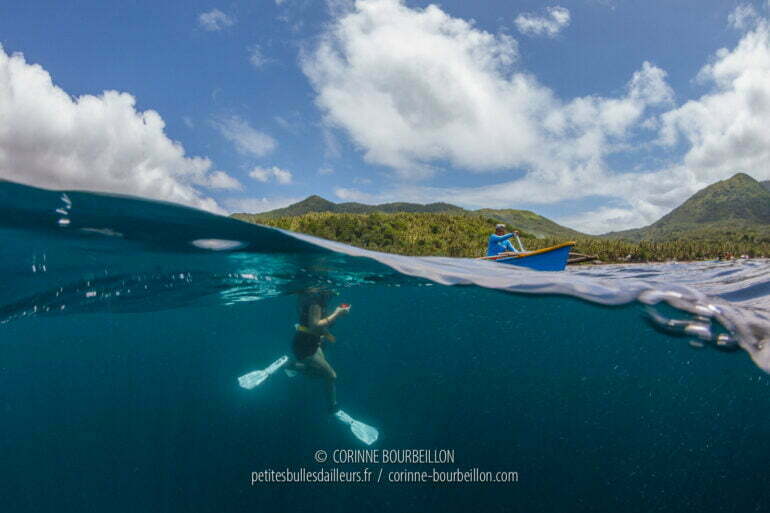

As I had experienced in 2014 in Mexico, snorkeling with whale sharks is sport... 😅 Nothing like scuba diving. It's much less comfortable and much more exhausting. You are tossed around by the swell on the surface and you have to fin hard to keep up with the beast that swims nearby, a few meters deep.
The big guy moves forward peacefully, with a slow lateral movement of its tail fin, its mouth open, swallowing all it can of plankton. Despite its apparent slowness, it is moving fast. There is no point in swimming frantically to try to keep up with it. It's better to wait for it or one of its fellow creatures to come back. There are a few of them that day, swimming back and forth, in a loop, close to the coast. All you have to do is wait, watching for the cries and signs of the guides in their bancas.
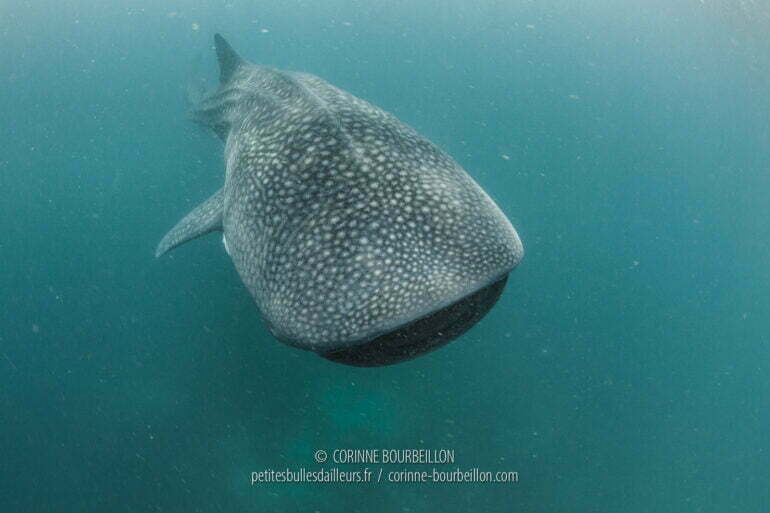

Beauty and power
To make pictures, the conditions are not ideal. The visibility is very bad, there are a lot of particles in suspension. We can see the shark appearing at the last moment in the greenish fog of the water, my autofocus is slipping.
I still managed to take a few photos and record short, slightly shaky video sequences of a specimen that kept passing by again and again, indifferent to our presence. I've put together a little footage, less than a minute long, which you can watch below.
The guides are well used to the comings and goings of the big fish. They regularly invite us to go back up with them on board their small bancas to let us go again a little further, or to hang on to the hull to breathe a little. They also make the broom boats to recover the most exhausted of the small humans who do not have enough energy to swim anymore...
I got a little further away from the others, when a guide nearby pointed to the water in front of me. I put my head back below the surface. The imposing whale shark that I filmed a few moments earlier is back. I switch back to turbo mode with my fins, to keep up with it on its starboard side, making sure I keep the required distance.
I see approaching the massive rectangle of the head, the gaping mouth, the tiny eye, the quivering slits of the gills and the faithful remora that waddle under its right pectoral. I contemplate, subjugated, the checkerboard with white dots which scrolls, the dorsal fin, and the slow and regular swimming of the enormous beast. What beauty, what power! But already it passed, and I tried to swim, but I could only see the coming and going of its tail, like a goodbye... And then it became a shadow and disappeared again in the turquoise mist.

I lift my head out of the water and decide to end my observation session there, on this magnificent bow. I signaled to a guide to pick me up in his mini-banca and bring me back to the SBSR boat, which was anchored a little further offshore.
Our little group is on board. We are amazed and delighted by our luck - it is not every day that we can observe such animals - but also a little frustrated by the poor visibility in the water full of plankton.
Feeding and over-tourism in Oslob
Pintuyan is not the only place in the Philippines where you can swim with whale sharks. Some 220 km away, on the island of Cebu, the village of Tan-Awan in the municipality of Oslob is the most famous site. And the most controversial.
If you're asked to go, say no. You'll understand why...
In Oslob, while whale sharks are no longer fished and slaughtered as in the past, they are now fed. This is called the feeding . Thus baited, many of these sharks stop migrating and remain year-round on the spot.
Accustomed to associating the presence of boats with food, they no longer hesitate to approach any boat at close quarters. Some get nicked by the propellers. As for fin strokes and contact with humans splashing in the water, they are almost systematic. A study published in October 2020 by researchers at the LaMaVe Institute has established that 95 % of Oslob whale sharks showed scars attributable to tourism.

95% of endangered Oslob, Cebu whale sharks injured due to tourism - study https://t.co/CQRFiM8Sfb
- Blue Planet Society (@Seasaver) October 9, 2020
Since 2012, whale sharks in Oslob have been the subject of a crazy tourist exploitation. At the end of 2011, images of fishermen, having fun throwing handfuls of shrimp to the sharks to attract them and amuse the few tourists at the time, spread through the media and social networks... And the crowds soon arrived, as the island of Cebu has an international airport, easy access to the archipelago and well connected to the capital Manila.
In six years, Oslob's annual tourist traffic has increased more than fivefold, from 98,000 in 2012 to 508,000 in 2018. Thanks to the friendly, gluttonous sharks, the once very poor fishing village has become a prosperous seaside resort. For many inhabitants, this is an unexpected change of life.
On Tan-Awan beach, you have to take your turn to splash around with the whale sharks for a few minutes... Below are a few tweets that illustrate the situation:
The video below dates from 2019, it is extracted from a report on overtourism in Oslob by Deutsche Welle, the German TV, adapted for Twitter by its Indonesian antenna. Even without understanding the language, the images speak for themselves:
Over the years, Oslob has developed a real "whale shark mass tourism" with the approval of the authorities. The rules for approaching these large wild animals without disturbing them are not respected at all. Their behavior and their diet are disturbed. So many disastrous drifts regularly denounced by environmental associations and scientists.
From fishing catches, whale sharks have become fairground beasts... 😳 Sad paradox.
"It's a mess in Oslob and the controversy is justified," comments the great American underwater photographer David Doubilet, in an article by National Geographic published in August 2018. But at the same time, "the sharks are alive and not lying dead, fins off, in a cold storage facility somewhere in Asia," he adds.
I put below the link of this article from National Geographic (originally published in English and translated into French), which sums up the paradox of Oslob's whale sharks, both protected and exploited:
➜ How did whale sharks become the favorite attraction of tourists?
At the end of January 2020, the LaMaVe Institute decided to suspend its scientific observations and educational interventions in Oslob (and I imagine that the health crisis then only endorsed this decision). The NGO deplores on its website "the lack of meaningful change and the reluctance of stakeholders at the local and regional level to abandon unsustainable tourism and management practices" regarding the interactions with whale sharks.
Since then, the coronavirus has been responsible for drying up the flow of international and Filipino tourists to Oslob: the number of bathers at the Tan-Awan site has dropped from more than a thousand a day, before the health restrictions, to only ten or so in early August 2020, when the authorities authorised the resumption of activities.
The impact of overtourism and feeding in Oslob has been the subject of a quantified and documented study by researchers from the LaMaVe Institute. Conducted from 2012 to 2018 , it was published at the end of 2020 on the Open Science website of the British Royal Society :
➜ The NGO statement: Long term study reveals no improvement in the impact of the whale shark tourism in Oslob, Philippines over 6 years
➜ The study: In-water observations highlight the effects of provisioning on whale shark behaviour at the world's largest whale shark tourism destination
Watching without (too much) disturbing
Having learned about these abuses in Oslob, the people of Pintuyan in southern Leyte do not want to make the same mistakes. The village is trying to develop a more ethical and responsible eco-tourism around the whale sharks of Sogod Bay. To create the conditions to observe them without disturbing them (too much).
So no feeding here. No crowds hungry for selfies-souvenirs in front of the big fish either.


In fact, the relatively isolated location of the region, far from major airports and tourist spots, has for the moment preserved it from an unmanageable influx of visitors. Between my first visit in 2008 and my stay in 2020, I did not notice any obvious change in the atmosphere. The area seems to me to have remained rather quiet.
I am hopeful that it will remain so. With unbaited whale sharks, small marine protected areas, local initiatives for the preservation of coral reefs, Sogod Bay attracts mainly patient and contemplative divers, visitors in love with nature, travelers in search of authenticity and simplicity. All of them are aware and a bit concerned about the potential impact of their activities on the environment.
When it comes to "whale shark tourism," Sogod Bay so far seems to have struck a balance between positive benefits for the local population and preservation of the big fish. In February 2020, the LaMaVe Research Institute updated on its website an assessment of its main observations in South Leyte, mixing science, tourism and social issues:
- 330 different specimens have been recorded in Sogod Bay.
- they're mostly juvenile males.
- a specimen identified in Sogod Bay was also identified in Taiwan, 1600 km away
- satellite tracking reveals that whale sharks in Sogod Bay frequent several other key habitats in the Bohol Sea
- the tourism model in South Leyte can be considered the most eco-friendly model in the Philippines for whale shark interactions (an impact study was conducted over three years from 2013 to 2016)
- thanks to the whale sharks, the women gathered in the community association Sea Breeze manage to generate additional income by making souvenirs that are sold to tourists in a sewing workshop created with the organization Sew Mates.
To learn more about the different whale shark programs conducted by LaMaVe Institute in South Leyte and elsewhere in the Philippines (Oslob, Donsol, Palawan, Tubbataha), you can visit their page below:
➜ Whale Sharks: Ensuring a future for the largest fish in the sea
Finally, if you can't see it in the water, you can admire the whale shark on the back of the Philippine 100 pesos banknotes (less than 2 €) issued from 2010, sign that it has become an animal that counts (a little) in the country...
More to read:
➜ All my posts about the Philippines
➜ All my posts about diving in the Philippines
➜ All my posts on whale sharks
Philippines: Sogod Bay [Leyte] + Moalboal [Cebu] + Pangatalan [Palawan] - March 2020


